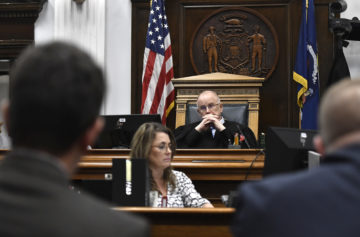Justin Blake alleges he was tortured, wrongfully arrested and suffered permanent damage by sheriff’s deputies after peacefully protesting the police shooting of his nephew Jacob Blake, in a lawsuit obtained by Atlanta Black Star.
Jacob Blake was shot seven times by Kenosha Police Officer Rusten Shensky in August 2020 and is now paralyzed. The shooting spurred protests in the Wisconsin city on Lake Michigan and parts of the country that summer. Kyle Rittenhouse was apprehended for killing two people and injuring one other as tension boiled over. The man’s uncle was arrested in April 2021 after he stood up against the county’s decision to send Shensky back into the field.
Although protests in Kenosha grew violent at times in the immediate aftermath of Jacob Blake’s shooting, Justin Blake said following his arrest as he was demonstrating outside of Kenosha’s Public Safety Building in April 2021 he was protesting with his silence before being forced into an emergency restraint chair in the Kenosha County Jail by about eight Kenosha County Sheriff’s deputies for seven hours.
Blake said he “suffered severe pain” because of the incident and was charged with disorderly conduct and obstructing, resisting an officer even though he was not resistant or disorderly in any way. He believes the deputies knew who he was and decided to lash out at him. The man sustained long-lasting injuries, including to his neck, back and shoulders. His attorneys filed the lawsuit on the second anniversary of his nephew’s police shooting.
“This case is the story of how failures in police accountability, failures in leadership, and a county steeped in racial inequities created the conditions which would lead to state-sponsored torture against Justin Blake, who stood up against these injustices by peacefully protesting for change,” the lawsuit says.
Blake filed the federal lawsuit on Aug. 23 against Kenosha County, Sheriff David Beth and the county’s two insurance providers. It names four deputies, a sergeant and other members of the force. He accused the deputies of using excessive force and unlawfully arresting him. Blake claims the county and its sheriff violated his First Amendment rights to freedom of speech and expression. He alleges Beth knew about the deputies’ actions but “did nothing to stop it.”
The lawsuit alleges the deputies retaliated against Blake for exercising his right to remain silent.
“When the KSD officers could not force Mr. Blake to speak or answer any questions, another John Doe officer said, ‘Put him in the damn chair!'”
“He was immobile, and restraints were tightly tied to his legs, arms, and he had a horse-like collar strap that went over his head and over his chest,” the lawsuit says.
The sheriff’s department said Blake was placed in the chair as a safety precaution so that deputies could remove items not allowed in jail cells, such as belts and shoelaces. Because Blake was mute, their only option was physical intervention.
“Instead of using physical force, our most peaceful option is to have them sit in the restraint chair,” Sheriff’s Capt. Eric Klinkhammer said. “It’s not used as punishment, it’s used so people can stay safe, and as soon as we can get someone out of the chair, we take them out.’
Blake alleges the county and its law enforcement agency also violated his Fourth, Eighth, and Fourteenth Amendment rights. He is seeking monetary and punitive damages and recovery of his medical expenses. In addition, he is asking the court to order the sheriff’s department to stop using restraint chairs and permanently delete his arrest records and other arrest and booking information.
County attorney Sam Hall said he plans to back the sheriff’s department’s use of the restraint chair in court.
“The restraint chair is an approved law enforcement tool used nationally in the corrections setting and is a vital part of ensuring safety of inmates and officers in a jail,” Hall said in a statement. “We will be providing a robust defense in this litigation to establish that the use of the restraint chair was appropriate in this circumstance.”


